Octopia is premium downloadable content for the post-apocalyptic action and adventure videogame Eastward. In a major departure from its base, it reimagines the bleak and misanthropic Eastward setting as, of all things, a whimsical farmlife simulation.

Explicitly set in a different world and focusing on an alternate John and Sam, the mismatched pair who rode an ominous train in search of a home in Eastward, Octopia sees the duo emerging from yet another dilapidated train station into the titular abandoned theme park. Settling into a rough shack beside an empty field, they begin new lives as subsistence farmers. Using the produce they grow on their farm, John leverages his talent for cooking into an accidental career as a farm-to-table chef. As John’s fame grows over a few prosperous months, the abandoned theme park grows into a thriving community that draws new residents and visitors from around the world. Octopia gives John and Sam the opportunity they were repeatedly denied in Eastward: A home where they are welcome and a life filled with peace and happiness.
Farmlife simulations are worn cliches by this moment in indie videogame design. The loop of waking up, planting and watering crops, tending to livestock, selling produce, visiting neighbors, sleeping, and repeating is familiar by now. Octopia makes an admirable effort to stand out in a crowded genre by making a few small but significant changes to the concept. The most prominent of these is how John must balance earning a profit with maintaining his stamina.
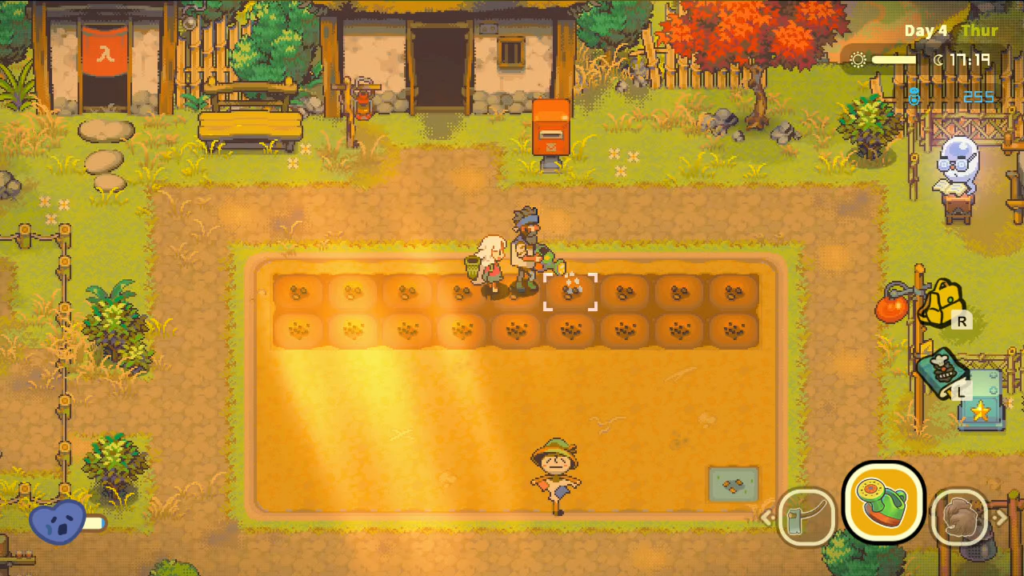
The player character’s stamina is a core statistic in most farmlife simulations. Nearly every action they perform drains a portion of their stamina total. Once it runs out, they can no longer do anything but the most basic actions like walking and talking to non-player characters. Options to restore stamina become available as the player character improves their property and stockpile resources. Before they are established, the most reliable way to replenish a drained stamina meter is by getting a good night’s sleep in their bed.
Octopia upends these familiar systems by making the amount of stamina John recovers from sleeping just a tiny fragment of his total stamina bar. If he relies only on a night in bed to keep up his energy, he will be unable to keep up with the tiring daily labor of maintaining his crops. The only way to ensure he has enough stamina is by preparing and eating meals using the cooking pot in the farmhouse. In many other farmlife simulations, the ability to cook meals is a mid-tier ability which is earned following an expensive house upgrade. In Octopia, the farmhouse is outfitted with a cooking pot from the first day by necessity.

John’s reliance on preparing meals to recover his stamina is further complicated by how their ingredients must come from his own farm plot. This puts two of John’s primary needs at odds with each other. Every crop he consumes to recover his stamina is a crop he cannot sell for salt, Eastward’s currency. Octopia is at its most interesting and compelling in the farm’s earliest days when John is broke and can barely endure watering the few crops he can afford to plant before collapsing from exhaustion. Every unit of salt prized from the environment and every free seed dropped by a startled bird feels like a gift which will keep the farm going for just a day longer.
This state of hardscrabble poverty does not last forever. As John’s cooking skill grows he learns to make more satisfying meals that restore more stamina, letting him work longer while using fewer ingredients. Through experimentation he discovers which crops give greater yields, increasing the profits he gains while minimizing the amount lost to his stomach. Eventually John is able to utilize every inch of his plot every day without expending all his stamina or sacrificing all his profit. This moment when the farm becomes a money maker is as satisfying in Octopia as it is in any other farmlife sim.

The remaining unique ideas Octopia brings to farmlife simulation are to streamline familiar design and activities. Most of the expected ideas are present but reduced down to their fundamentals.
No mechanic feels as streamlined as the passage of time. Days are short in Octopia. Beginning at 8am and ending at 8pm, each lasts about ten real-time minutes. This shortness of time makes the early days on the farm feel even more desperate.

Automation options are non-existent in Octopia. There are no sprinklers; every single crop must be watered individually with John’s watering can every single day. By the time John is done tending to the farm’s crops, about half the day and most of his stamina meter is gone. This leaves little time for scavenging roots and mushrooms or fishing in the swamp, beach, and city ruins adjacent to the farm. The act of farming in Octopia feels more laborious than in typical farmlife simulations.
Also missing is a shipping bin. Any money John earns from his farm is obtained by selling directly to a man named William and his two sons, one human and one robot and both named Daniel, who set up a shop in Octopia shortly after John and Sam move in. John seems to be their only customer; as the human Daniel states on days he services the shop counter, “we may not be the cheapest, but it’s not like you have any other choice.” The necessity to walk to the shop in order to sell produce adds several more hours to the daily routine.
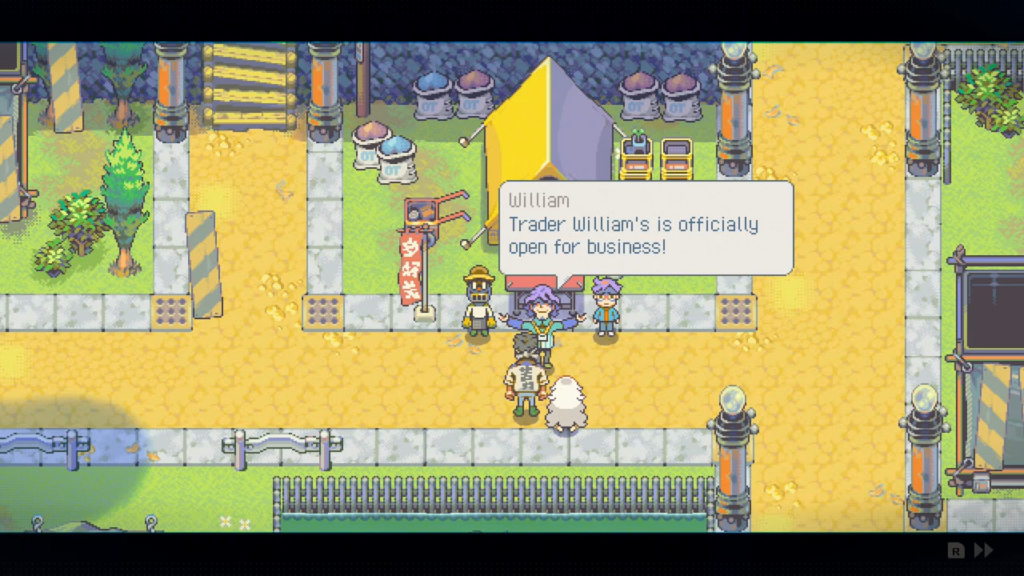
There are no seasons in Octopia, so the seeds the shop sells from day to day are random. Some days they may sell corn and pumpkins, while on others they sell grapes and peppers. All may be grown side-by-side in the farm plot with no apparent difficulty or ill effects. Whatever calamity that befell Eastward’s world must have obliterated any sense of recognizable or coherent climate.
The lack of seasons may be the most dramatic change Octopia brings to farmlife simulation. With no natural sense of the passage of time, there’s nothing to wait for or anticipate. When any crop may be grown at any time, none feel special or scarce. There are no holidays to break up the monotony of daily chores and milestone progress through the year. There are no years; the day of the week is the only mark of time and it has no notable impact on anything happening around town. Every day in Octopia feels exactly like every other one. John and Sam’s new life feels less like an idyllic retirement and more like purgatory.

A few days after William and his sons move in, a construction robot named Mung moves into the plot next to the shop. By visiting a board set up in Mung’s yard, John can take on construction projects. John can contribute to a project’s completion by depositing wood, rocks, and salt he gathers from around Octopia. Completing projects improves Octopia’s infrastructure, expanding the number of fertile fields around the farm, upgrading William’s shop from a flimsy tent to a modern convenience store, and enlarging the farmhouse to allow John to host dinner parties for Octopia’s residents and visitors.
None of these construction projects are demanding of John’s resources. John already has enough wood and stone in his pockets to complete every project before it begins. There are only a handful of projects in total to complete. While it takes me more than one hundred in-game days to reach Octopia’s credits, John exhausts all of Mung’s construction projects before reaching the fiftieth. Even after completing all their projects, Mung and his employees continue to hang around Octopia with nothing to do.
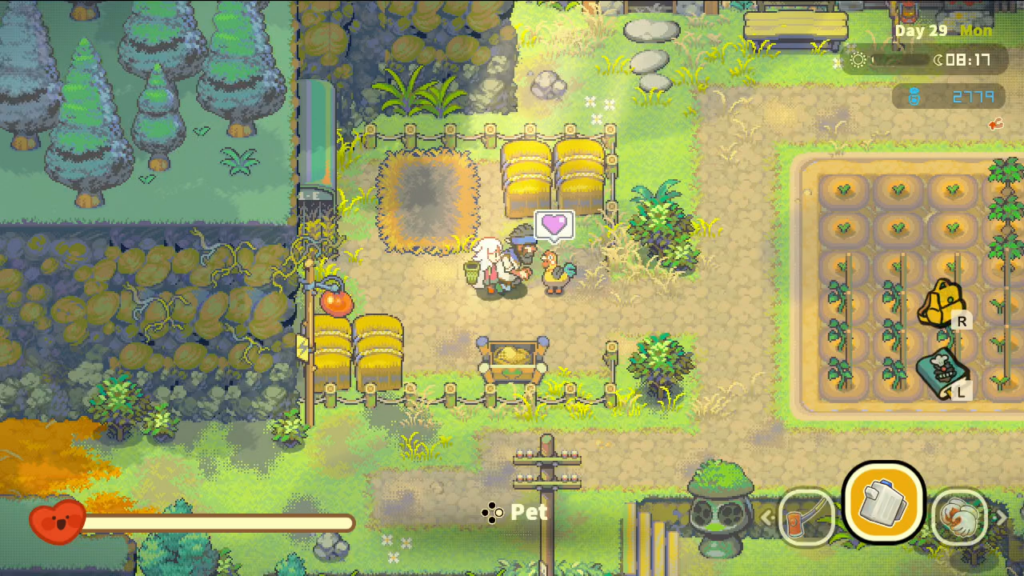
Two of Mung’s projects add a coop and barn to the farm, allowing John to raise chickens, pigs, and cows. In one of Octopia’s few overt portrayals of its post-apocalyptic setting, these animals are different from those we would recognize. Chickens appear normal enough but lay two or three eggs a day. Pigs have tiny mosquito wings that flutter with blinding speed to support their bulk. Cows have lost their hind limbs and float continuously on helicopter blades that sprout from their backs. None of these mutations affect their produce.
Animal husbandry is where Octopia feels most streamlined. Animals are not purchased. Instead they are encountered around Octopia and automatically move to the farm after the right building is constructed. All John must do to care for them is feed and pet them once a day and open their enclosures’ doors when it’s not raining. There are no tools needed to gather their resources. Chickens helpfully lay eggs in the same spot every day. Pigs grow mushrooms on their heads, somersaulting to drop them on the ground when John comes to collect. Cows may be milked without requiring so much as a bucket. Animals even reproduce automatically. They require so little effort and give so much back that building a coop and a barn is where John’s difficulties balancing his stamina and his profit vanish. The only minor speedbump is animals’ feed may only be purchased in William’s shop; it’s cheap and restocks every day, so the only way to run out is to purposefully ignore buying more.

As John completes his daily chores, he randomly uncovers energy gems from just about any activity. These items are the key to Octopia’s final and most extreme form of streamlining. After Alva and Isabel establish their science lab in Octopia, John may spend an energy gem and small amount of salt to make spectacular things happen on his farm. Every planted crop can mature in an instant. The chickens spontaneously lay golden eggs. John gains superhuman strength, letting him chop rocks and trees with a single blow from his axe. As John masters his routine he finds new energy gems almost every day. With enough salt and gems, the farm’s output goes from an improbable videogame construction to an impossible magical ideal from a fairytale.
In a farmlife simulation where everything is already streamlined and simplified, the addition of energy gems feels like overkill. I almost never direct John to use them. He reaches the credits with hundreds of them in his pockets. As much as I appreciate the initial tension Octopia creates between John’s stamina and his profit margin, it is still a low-difficulty example of its genre. The bonuses conferred by energy gems take that low difficulty and trivialize it to where playing Octopia doesn’t feel rewarding at all.
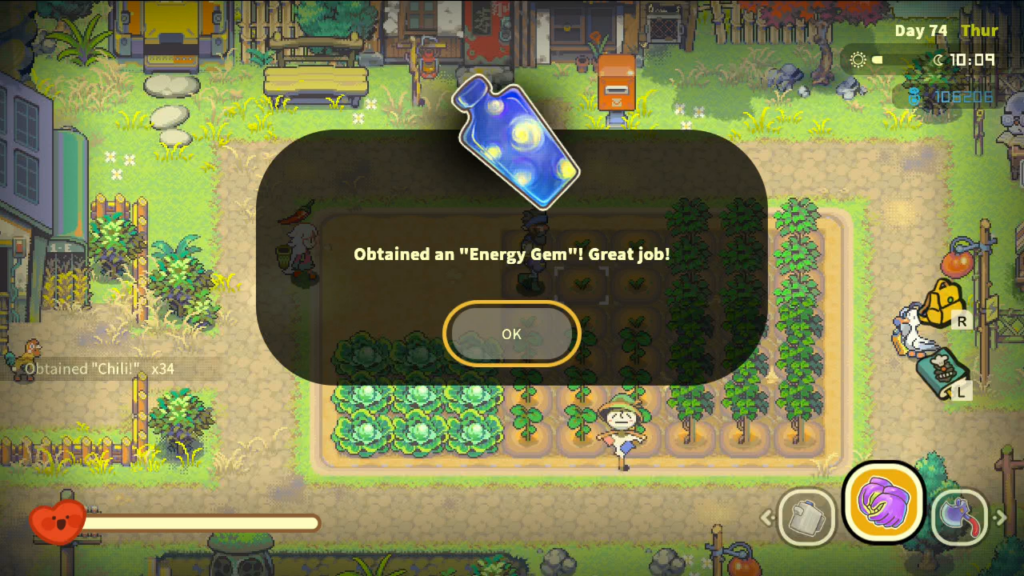
As in most farmlife simulations, the improvements to the farm are a mostly open-ended process. John can choose which upgrades to prioritize and which crops he plants. Octopia steers him towards certain outcomes through its new residents and visiting tourists. Each of them has a particular food they’ve heard and wish to try.
In order to progress through Octopia, John must gather the ingredients for these foods, prepare them in the farmhouse’s cooking pot, and deliver them to the character that requests them. These requests often drive John to develop another aspect of the farm. Someone inevitably asks for a meal that needs eggs, requiring John to raise chickens, or they ask for beer, requiring John to grow wheat and brew it in a cask in his basement. Successfully delivering these requests adds to Octopia’s functionality, either increasing the number of devices and services John has access to, or adding new seeds to the pool of crops for sale in the shop.
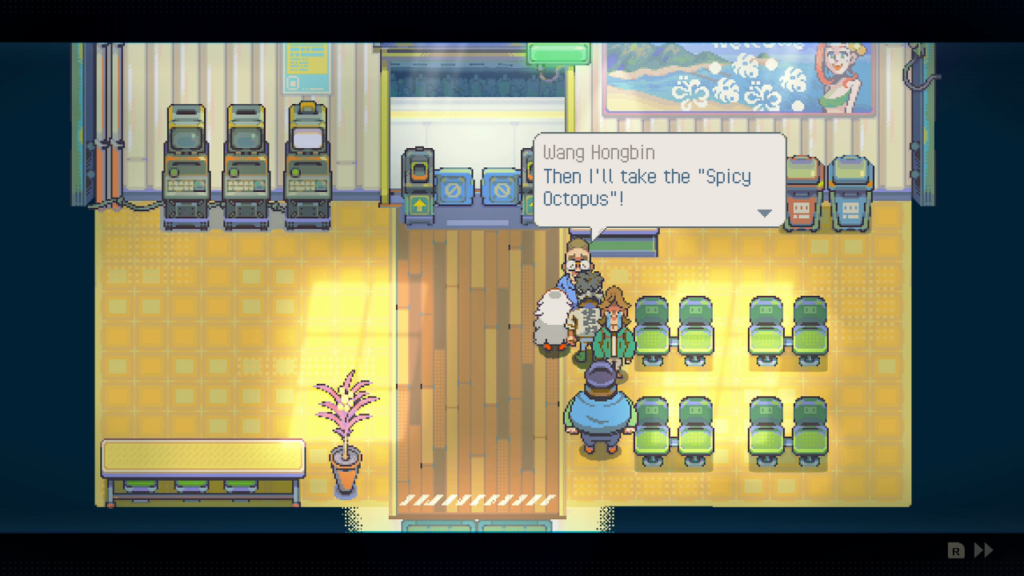
It doesn’t take me long to anticipate these requests and begin stockpiling some of every kind of ingredient. There is no inventory cap in Octopia, so I ensure John’s pockets are filled with stacks of eggs, milk, and every kind of vegetable, mushroom, and root. About the only thing that may catch John by surprise is the occasional need for specific fish, some of which can only be caught at certain locations in precise weather. Even if all the conditions are right, catching the fish John needs still involves a certain amount of luck. The need for sardines or crabs and the uncertainty of catching them are the only moments John gets stuck on a character’s request.
Every farmlife simulation reaches a point where there isn’t much left to do. The farm has reached its maximum potential. Every upgrade has been purchased. Relationships with the player character’s friends and neighbors cannot be improved further. Octopia’s greatest weakness is it reaches this point much too soon.

Mung’s construction projects are the best example of this problem in action. Wood and stone serves no other purpose than to complete Mung’s projects and upgrade John’s tools. Once all of them are completed, John’s axe and the mining minigame—a computerized machine whose interface mimics 8-bit arcade videogames—become pointless. I try to fill in John’s afternoons and evenings with fishing. This, too, begins to feel pointless once John is carrying more than enough of every fish to cook every pescatarian meal multiple times.
I eventually reach a point where once John is done tending to his crops and selling his bounty in William’s shop that I end the day then and there in the hopes that when he wakes the next day, Octopia will have a new visitor requesting a new dish from John’s cookbook. Even doing this much is me indulging my stubborn pride; John has hundreds of thousands of salt units and his inventory overflows with every kind of crop. There is simply no point in going to the effort of growing more. It takes many weeks of waiting through nothing happening for Octopia’s final visitor to appear and the uneventful story to reach its conclusion.
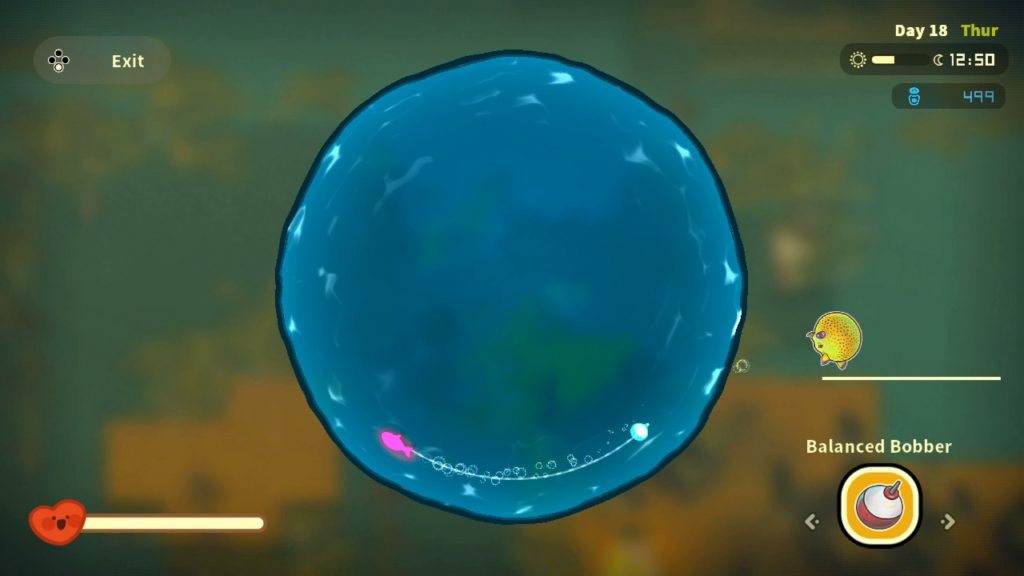
Octopia’s real trouble is that its farmlife mechanics are so streamlined and their potential so limited that all sense of growth, progress, and momentum drags to a halt around the sixtieth in-game day. In my experience, I must endure another fifty days of little changing and not much happening before the credits finally roll on an inconclusive and unsatisfying note.
Even before I purchase Octopia, a question is at the forefront of my mind: Why is it downloadable content for Eastward and not a standalone spinoff? Why use DLC to radically alter the experience offered by its core videogame? I am not strictly opposed to the idea of using downloadable content to change a videogame’s central ideas but it needs to be successful in that change. The result in Octopia is a videogame which will satisfy few.

Eastward fans who do not like farmlife simulations will be disappointed that the story’s continuation is in a form they will not enjoy. To them I offer the solace that this is a different John and Sam from the pair we follow in Eastward. I am haunted by this knowledge as a play. If their alternate life as successful celebrity farmers is meant to be recompense for the hell the main pair endure in the core story, it’s a bitter reward. The final visitor brings a desperate, last-minute connection to the original Eastward story, but their departure is inconclusive. Octopia offers no catharsis to the original John and Sam.
Farmlife simulation fans will be disappointed by Octopia’s rudimentary vision. It makes one or two interesting changes to expected norms but they become non-factors as the farm thrives. The remaining changes streamline those norms down to a razor edge so sharp it is unpleasant to spend much time with them. I am an experienced farmlife simulation player and after two in-game months I was sending John to bed every day before noon because there was simply nothing left to do. Despite this static existence, there were still more than a month left of additional visitors to satisfy.
In any way Octopia is approached, it is a dreadful disappointment.